Welcome fellow workshop enthusiasts! Today, we delve into the crucial art of balancing natural and artificial light in your garage workshop – a topic often underestimated but essential for a productive and enjoyable workspace. As an expert in workshop lighting and electrical setups, I am excited to share valuable insights on how to optimize your lighting environment for maximum efficiency and comfort.
Efficient lighting in a garage workshop is more than just illuminating your space. It impacts your mood, productivity, and even the quality of your work. Striking the right balance between natural light, which uplifts and invigorates, and artificial light, which provides consistent brightness, is key to creating a harmonious work environment.
While natural light is the ideal choice for its stimulating properties, it can be inconsistent and insufficient, especially during evening or cloudy days. That’s where artificial lighting steps in to fill the gaps, ensuring a well-lit workspace regardless of the external conditions.
Join me on this illuminating journey as we explore the various techniques, fixtures, and setups to achieve the perfect blend of natural and artificial light in your garage workshop. Let’s transform your workspace into a beacon of creativity and productivity by mastering the art of lighting balance.
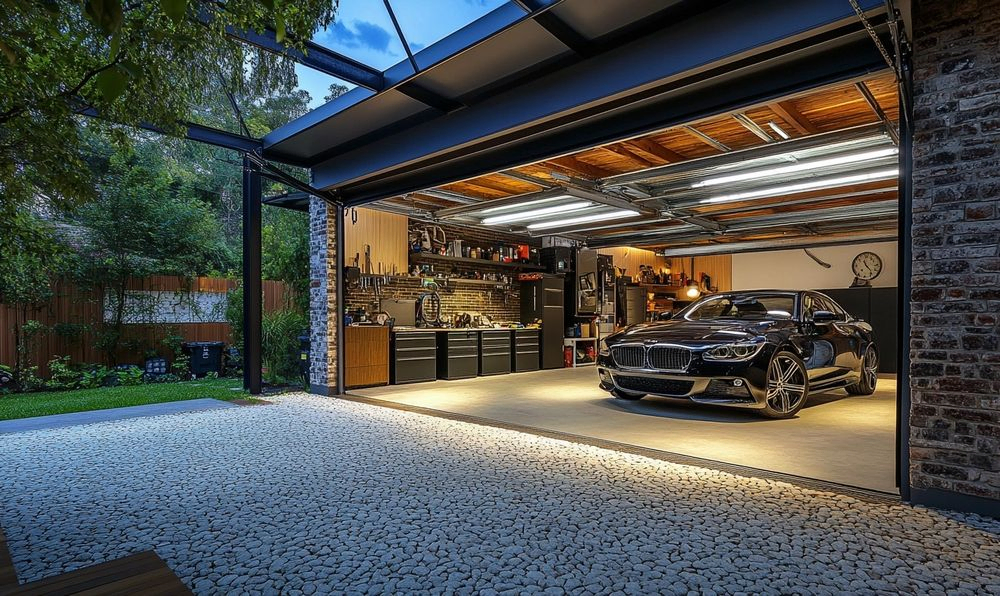
Let There Be Light: Finding the Perfect Balance
Lighting is more than just a practical consideration in your garage workshop. It’s the secret ingredient that can transform your space from a dim and dreary corner into a vibrant hub of productivity and creativity. By striking the right balance between natural and artificial light, you can create an environment that not only enhances your work but also uplifts your mood and boosts your efficiency.
A Symphony of Light: Harnessing the Power of Natural Sunshine
Embrace the gift of natural light streaming in through windows and skylights. The sun’s rays can invigorate your workspace, providing a sense of warmth and openness that artificial lighting simply cannot replicate.
Consider these benefits of incorporating natural light into your workshop:
- Boosts mood and productivity
- Reduces eye strain and fatigue
- Enhances color accuracy for intricate tasks
Creating a Harmonious Blend: Choosing the Right Artificial Lights
When the sun sets or on cloudy days, trust artificial lighting to pick up the slack. Opt for LED lights that mimic natural daylight, providing a crisp and bright illumination that closely resembles the sun’s glow. Balance is key – not too harsh, not too dim, but just right.
Benefits of incorporating artificial lighting include:
- Consistent lighting regardless of weather or time of day
- Ability to control brightness levels for various tasks
- Long-lasting and energy-efficient solutions
Setting the Stage: Positioning Your Lights Strategically
Arrange your lights strategically to ensure every nook and cranny of your workshop is well-lit. Think of your lighting setup as a conductor leading an orchestra – each light source playing its part to create a symphony of illumination that shines a spotlight on your craftsmanship.
Consider these key lighting positions:
- Overhead lights for general brightness
- Task lighting for specific work areas
- Accent lighting to highlight tools or decor
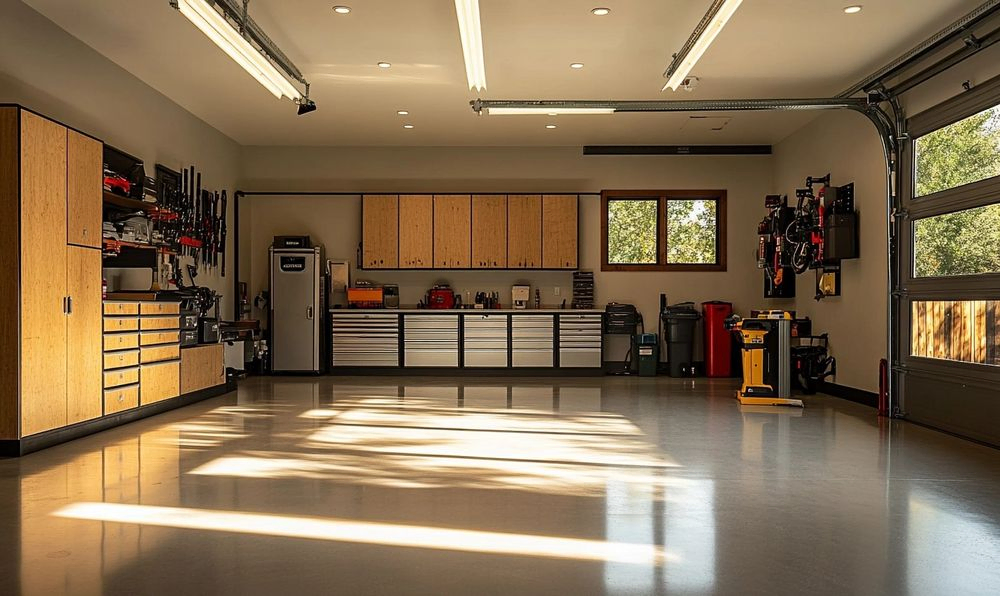
Assessing Natural Light Sources in Your Garage Workshop
When it comes to setting up your garage workshop, one key element that can significantly impact your work environment is the balance between natural and artificial light. Natural light not only brightens up your space but also has numerous benefits for your mood, productivity, and overall well-being. So, how can you make the most of the natural light sources in your garage workshop?
Maximizing Window Placement:
Position your workbench or main workspace near windows to harness the maximum amount of natural light throughout the day.
Utilizing Skylights:
If your garage has the option for skylights, consider installing them to bring in additional natural light from above, creating a well-lit and airy atmosphere.
But what about those gloomy days or late-night projects when natural light is scarce? That’s where artificial lighting comes into play. Choosing the right artificial lighting is crucial to ensure adequate brightness and visibility in your workshop.
Task Lighting for Precision:
- Use directed task lighting, such as adjustable desk lamps or under-cabinet lights, for detailed work that requires focused illumination.
- Task lights help reduce eye strain and minimize shadows on your work surface, aiding in your precision and accuracy.
Creating a Balanced Environment:
Harmonizing natural and artificial light sources in your garage workshop is like finding the perfect recipe for your favorite dish. The right blend ensures a balanced, well-lit environment that promotes comfort and boosts your efficiency.
Ultimately, your workshop’s lighting setup should aim to enhance safety, productivity, and creativity. By assessing your natural light sources and strategically integrating artificial lighting, you can create a workspace that’s not only functional but also conducive to your best work.
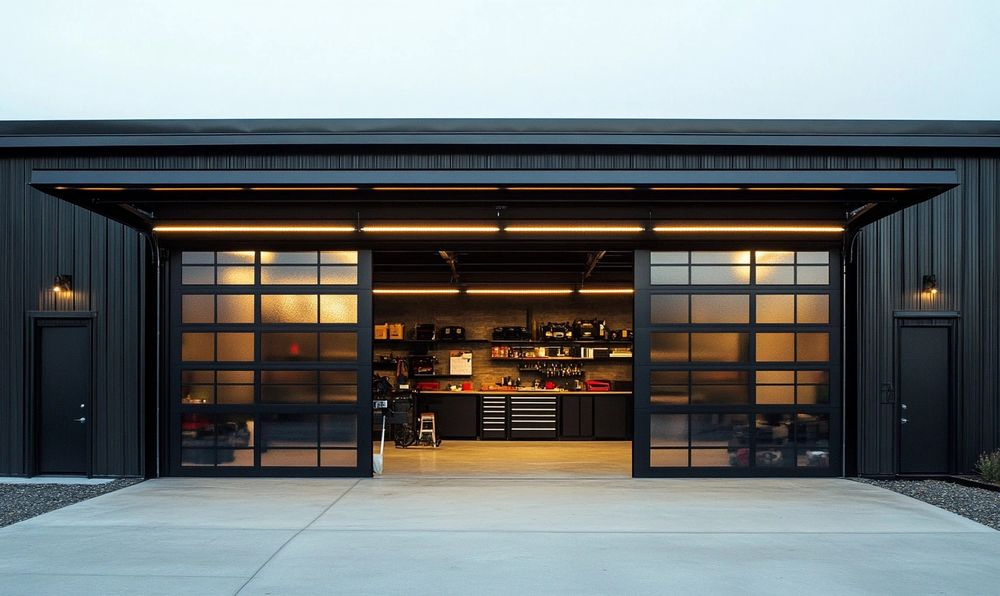
Choosing the Right Artificial Lighting for Your Workspace
So, you’ve set up your garage workshop and assessed the natural light sources. Now, it’s time to delve into the world of artificial lighting to ensure your workspace is perfectly illuminated for your projects. Let’s explore some essential tips on selecting the right artificial lighting for your workshop:
Consider the Type of Light
When choosing artificial lighting, consider the type of light you need. Do you require bright, white light for detailed tasks or a softer, warmer glow for a cozy ambiance?
Opt for LED Lighting
LED lights are energy-efficient, long-lasting, and provide ample brightness for your workshop. They are a fantastic choice for both task lighting and overall illumination.
Evaluate Light Fixtures
Ensure your light fixtures are durable and suitable for a workshop environment. Look for fixtures that are easy to clean and maintain to keep your workspace bright and safe.
Focus on Task Lighting
Task lighting is crucial for specific work areas such as your workbench or tool storage. Installing adjustable task lights can enhance visibility and reduce eye strain during detailed tasks.
Layer Your Lighting
Layering light sources creates a balanced and dynamic workspace. Combine overhead lighting with task lights and ambient lighting to customize the intensity and mood of your workshop.
And remember, finding the perfect balance between natural and artificial light is like mixing the right ingredients in a recipe – it creates a harmonious and productive environment for your projects.
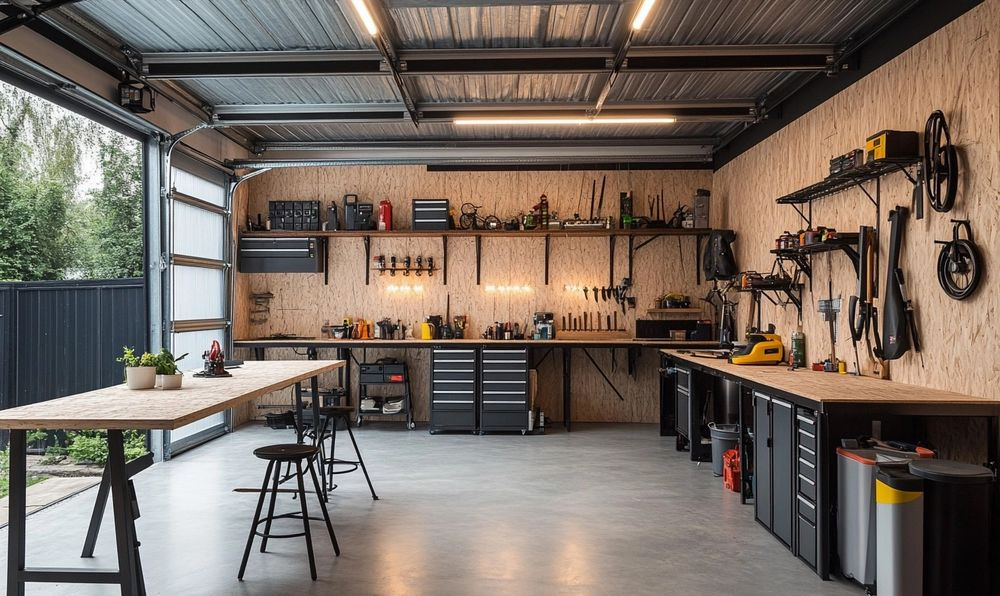
Maximizing Natural Light to Enhance Productivity
Hey there, fellow workshop enthusiast! Let’s shed some light on how you can optimize natural light in your garage workshop to boost your productivity and create a vibrant workspace.
Embracing the Power of Sunshine
Have you ever noticed how your mood instantly lifts when the sun streams into your workshop? Sunlight has a magical effect on our mindset and productivity levels. It sparks creativity, enhances focus, and reduces eye strain – a win-win for your projects!
Strategic Placement of Workstations
Position your workbenches and tools near windows or skylights to make the most of natural light. A well-lit workspace not only improves visibility but also creates a welcoming and refreshing atmosphere.
And who doesn’t enjoy working in a space that feels like a sunny haven?
Harnessing the Benefits of Daylight Harvesting
Daylight harvesting involves using reflective surfaces like white walls or mirrors to bounce sunlight deeper into your workshop. This technique not only brightens up dim corners but also reduces the need for excessive artificial lighting during the day.
- Rearrange your workshop layout to maximize sunlight exposure
- Add light-colored curtains or blinds to regulate brightness levels
- Incorporate light-shelves to direct sunlight where it’s needed most
Creating a Cheerful and Inviting Ambiance
Picture your workshop as a sun-dappled oasis where creativity flows effortlessly. The warm glow of natural light can transform a dull space into a vibrant sanctuary that inspires your projects and motivates you to dive into work with renewed energy.
By harmonizing natural and artificial light in your workspace, you can strike a perfect balance that enhances both functionality and aesthetics. So, go ahead, open those curtains, let the sunshine in, and watch as your productivity soars to new heights!
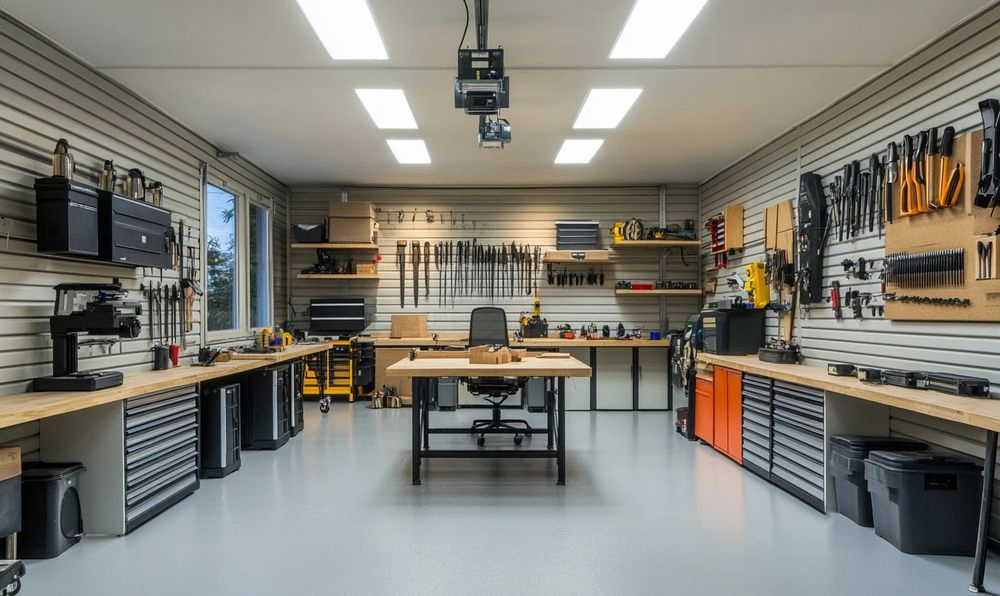
Utilizing Task Lighting for Specific Work Areas
Hey there, fellow workshop enthusiast! When it comes to optimizing your garage workspace, having the right lighting setup can make a world of difference in your productivity and overall enjoyment of your projects. Let’s dive into the wonderful world of task lighting and how it can elevate your specific work areas.
Customizing Your Illumination
Think of task lighting as the spotlight on a performer during a show. It helps highlight and focus on specific tasks or areas, allowing you to work with precision and clarity.
Here are a few key points about utilizing task lighting:
- Task lighting should be adjustable to cater to various project requirements.
- Consider LED lights for energy efficiency and long-lasting brightness.
- Position task lights strategically to minimize shadows and glare.
Enhancing Work Efficiency
Imagine trying to paint a detailed model or assemble small parts under poor lighting. It’s like trying to navigate through a dense forest without a flashlight – frustrating and ineffective.
By incorporating task lighting in your workshop, you can streamline your work process and boost your efficiency significantly. It’s like having a personal spotlight that guides you through every intricate step of your project.
So, why settle for dim and inadequate lighting when you can tailor your workspace with task lighting that illuminates your path to success?
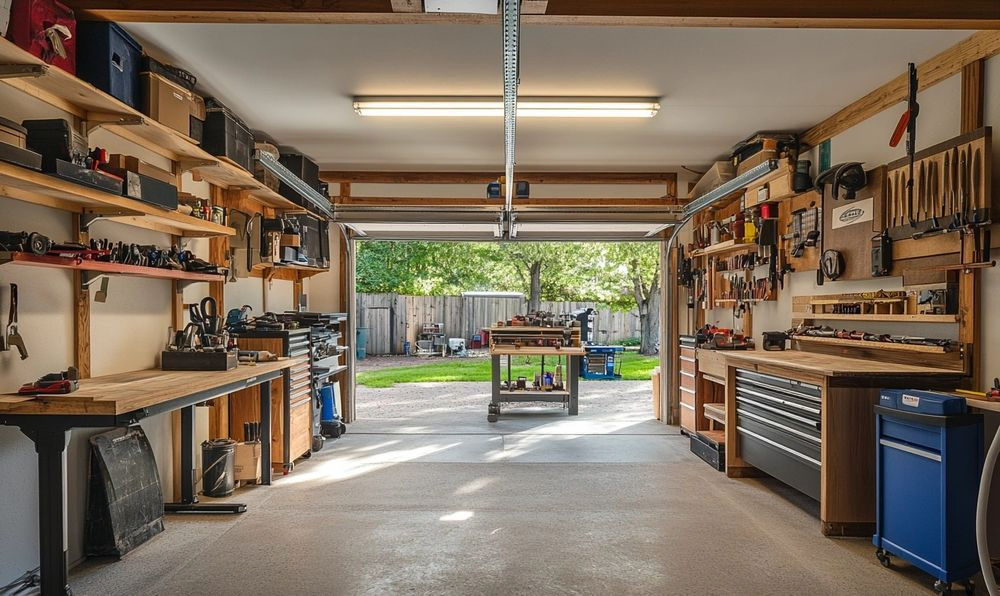
Harmonizing Natural and Artificial Light for a Balanced Environment
When it comes to setting up your garage workshop lighting, finding the perfect balance between natural light and artificial illumination is crucial. Striking this harmony not only enhances the aesthetic appeal of your workspace but also boosts productivity and creates a comfortable environment for your projects.
Embracing the Best of Both Worlds
So, how can you create a harmonious blend of natural and artificial light in your workshop? Here are some tips to help you achieve the perfect equilibrium:
- Maximize Natural Light: Position your workbench or main workspace near windows or skylights to make the most of natural sunlight.
- Layer Lighting: Combine overhead fixtures with task lighting to ensure even illumination throughout the space.
- Adjustable Settings: Opt for lighting solutions that offer dimming options to adapt to changing natural light levels throughout the day.
Finding Your Lighting Balance
Creating a balanced lighting environment involves considering the type of tasks you’ll be performing in your workshop and how natural light fluctuates throughout the day. By blending the best aspects of both natural and artificial light sources, you can achieve a well-lit, inviting workspace.
Remember, good lighting not only illuminates your projects but also your creativity and inspiration. It sets the mood and vibe of your workspace, impacting your mood and energy levels. So, don’t underestimate the power of light in your garage workshop!
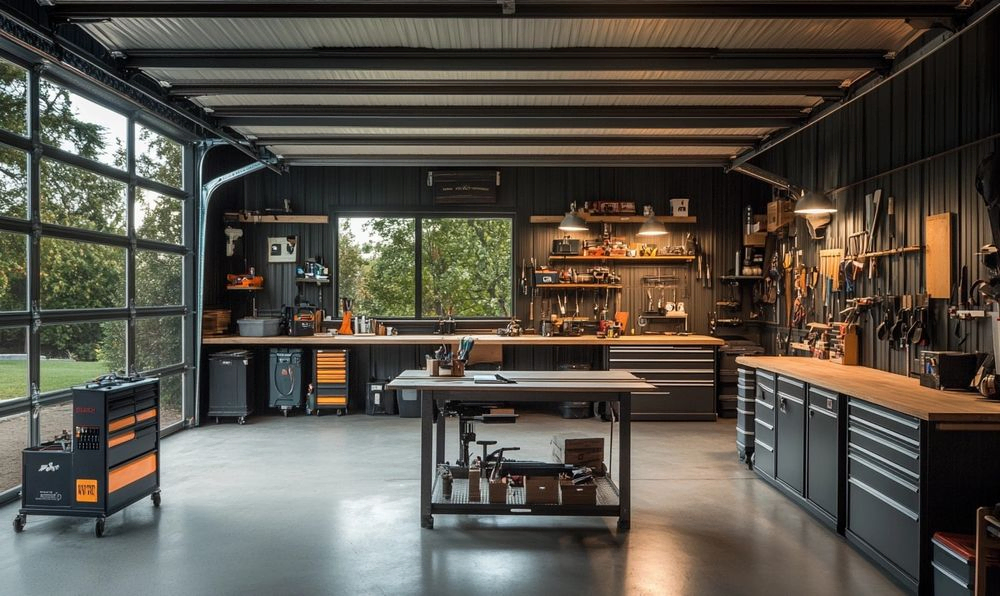
Enhancing Safety with Adequate Lighting Solutions
When it comes to setting up your garage workshop, lighting is not just about brightening up the space for better visibility. It also plays a crucial role in ensuring your safety and preventing accidents. Here’s how you can enhance safety in your workspace by striking the right balance between natural and artificial light sources:
Illuminate Every Nook and Cranny
Balancing the light distribution is key to avoiding shadowy corners that can hide hazards. Make sure your lighting setup reaches every area of your workshop.
Prevent Eye Strain
Insufficient lighting can lead to eye strain and fatigue, increasing the risk of accidents. Adequate lighting ensures you can see clearly and work efficiently without straining your eyes.
Reduce Tripping and Slipping Hazards
Well-lit workspaces help you identify potential trip or slip hazards, such as tools or spills on the floor. By ensuring proper lighting, you can navigate the workshop safely.
In a workshop, safety should always be a top priority. By optimizing your lighting solutions, you not only create a well-lit and productive environment but also minimize the risks of accidents and injuries.
Adjusting Light Levels for Different Workshop Activities
Lighting in your garage workshop isn’t just about brightening up the space; it’s about creating an environment that supports different tasks effectively. Each activity requires a different level of illumination to ensure safety, productivity, and precision. Let’s explore how you can tailor your lighting setup for various workshop activities.
Crafting and Detail Work
When engaging in intricate tasks like woodworking or electronics repair, bright, focused lighting is crucial. Consider using task lighting such as adjustable desk lamps or under-cabinet lights to illuminate your work surface effectively.
General Workspace Illumination
For general workshop activities like organizing tools or cleaning up, you’ll need even, ambient lighting throughout the space. Overhead LED fixtures or fluorescent tube lights can provide consistent brightness without creating harsh shadows.
Vehicle Maintenance and Repairs
When working on your car or tackling mechanical projects, you’ll need bright, uniform lighting that covers the entire workspace. Consider installing LED shop lights or dual-bulb fixtures to ensure you have ample light for detailed inspections and repairs.
And how do you balance natural and artificial light to create the perfect environment for your workshop activities? Share your thoughts with us!
Positioning Lights Strategically for Optimal Illumination
Lighting is a crucial component in any garage workshop, as it not only illuminates the space but also impacts your productivity and safety. By strategically positioning lights, you can create a well-lit environment that enhances your work experience. Here are some tips for achieving optimal illumination in your workshop:
Consider the Layout of Your Workspace
The first step in positioning lights effectively is to assess the layout of your workshop. Take note of where your workstations are located, as well as any potential obstacles that could block the light. By understanding the flow of your space, you can determine the best placement for lights to ensure even coverage.
Utilize a Combination of Lighting Sources
Balancing natural and artificial light can help create a dynamic and well-lit workspace. While natural light is ideal during the day, artificial lighting is essential for evening or cloudy days. By incorporating a mix of sunlight and overhead, task, and LED lights, you can customize the illumination based on your needs.
Focus on Task Lighting for Specific Work Areas
For detailed tasks that require precision, such as woodworking or crafting, task lighting is key. Position adjustable lights above your workbench or tool area to ensure that you have sufficient light without creating glare or shadows. This targeted approach can enhance your focus and accuracy.
And, don’t forget to consider the color temperature of your lights. Warmer hues can create a cozy atmosphere, while cooler tones are ideal for high-focus activities.
When positioning lights in your workshop, think about how you can maximize natural light sources, incorporate different lighting types, and tailor the illumination to specific work areas. By finding the perfect balance between natural and artificial light, you can create a well-lit, inviting, and productive workspace that inspires creativity and efficiency.
Exploring Energy-Efficient Lighting Options for Savings
Let’s dive into the realm of energy-efficient lighting for your workshop. Not only will it save you money in the long run, but it will also contribute to a greener environment. So, how can you light up your space without burning a hole in your pocket? Let’s find out!
LED Lights: The Eco-Friendly Choice
When it comes to energy efficiency, LED lights are the undisputed champions. They consume significantly less energy compared to traditional incandescent bulbs and last much longer. It’s like switching from a leaky bucket to a sturdy water jug that conserves every drop.
Smart Light Controls: Efficiency at Your Fingertips
Investing in smart light controls can further optimize your workshop’s energy consumption. With features like motion sensors and dimmers, you can ensure that lights are only on when needed, just like having a personal assistant managing your illumination needs.
Solar-Powered Lighting: Harnessing the Power of the Sun
Solar-powered lights are an excellent choice if you want to reduce your workshop’s carbon footprint. By harnessing the sun’s energy, you can illuminate your workspace sustainably, almost like having your mini sun shining bright within your garage.
By incorporating these energy-efficient lighting options, you’re not only saving on electricity bills but also doing your part in fostering a more sustainable future. Effective lighting in your workshop is not just about brightness; it’s about balance, efficiency, and environmental consciousness.
Maintaining and Updating Your Lighting Setup for Longevity
Just like a well-timed tune-up for your car, your garage workshop’s lighting setup requires regular maintenance and occasional updates to ensure it functions optimally. By investing time and effort into caring for your lighting system, you not only prolong its lifespan but also create a safer and more efficient working environment for yourself.
Regular Maintenance Tips:
- Wipe down light fixtures to remove dust and dirt that can diminish brightness.
- Check for any flickering or dimming lights that may indicate a need for bulb replacement.
- Inspect wiring for any signs of wear or damage, such as fraying or exposed wires.
Updating Your Lighting Setup:
- Consider upgrading to LED bulbs for energy efficiency and longevity.
- Add dimmer switches to adjust light levels according to different tasks and preferences.
- Install motion sensor lights for convenience and enhanced safety.
By staying proactive with the upkeep of your workshop lighting, you not only save money in the long run but also create a workspace that is conducive to productivity. Think of your lighting setup as the heartbeat of your workshop – when it’s strong and steady, everything else falls into place effortlessly. Let’s dive into some practical tips for maintaining and updating your lighting setup for the long haul.
Prolonging the Life of Your Lighting System:
Regular cleaning and inspection can go a long way in ensuring your lighting setup remains effective and reliable. Think of it as giving your tools a tune-up to keep them in top shape for years to come.
Embracing Technological Advancements:
Don’t be afraid to embrace new lighting technologies that can enhance your workspace. Updating your setup with energy-efficient LED bulbs not only saves on electricity costs but also provides a brighter and more consistent light output.
Remember, a well-maintained and updated lighting system not only illuminates your space but also sets the tone for a productive and safe workshop environment. So, take the time to care for your lights – they’ll shine bright in return!
Conclusion
In conclusion, achieving the perfect balance between natural and artificial light in your workshop is essential for creating a productive and comfortable working environment.
By harnessing the benefits of natural light through strategically placed windows, skylights, or even solar tubes, you can reduce energy costs and enhance the overall ambiance of your space.
Supplementing natural light with high-quality artificial lighting fixtures, such as LED overhead lights or task lighting, ensures that you have adequate illumination for detailed tasks and night-time work.
Remember to consider the color temperature of your artificial lights to mimic natural daylight and prevent eye strain during long hours of work.
Ultimately, the key to an efficient and well-lit workshop lies in finding the perfect synergy between natural and artificial lighting sources to create a well-lit, inviting, and inspiring space for all your projects and creations.
Frequently Asked Questions (FAQs)
How important is it to balance natural and artificial light in a garage workshop?
It is crucial to balance natural and artificial light in a garage workshop to create a productive and safe working environment.
What are the benefits of incorporating natural light into a workshop?
Natural light reduces eye strain, enhances color accuracy, and boosts mood and productivity.
How can skylights or windows improve natural lighting in a garage workshop?
Skylights and windows allow ample natural light to enter the space, reducing the need for artificial lighting during the day.
What types of artificial lighting are suitable for a garage workshop?
LED overhead lights, task lighting such as LED strip lights, and adjustable workbench lights are popular choices for garage workshops.
How can I control the balance between natural light and artificial light in my workshop?
Use adjustable curtains or blinds on windows, install dimmers on artificial lights, and position workstations to make the most of natural light.
What should I consider when setting up electrical outlets in a garage workshop?
Ensure outlets are GFCI protected, strategically placed for tools and equipment, and consider dedicated circuits for heavy machinery.